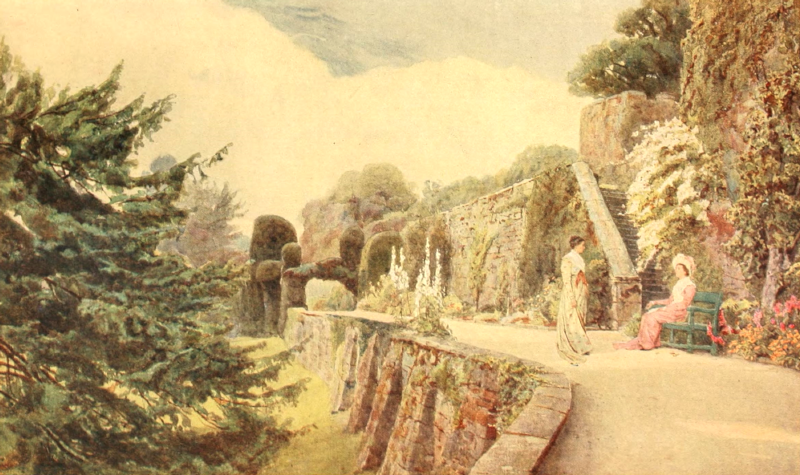| Web
and Book design,
Copyright, Kellscraft Studio 1999-2021 (Return to Web Text-ures) |
 (HOME)
|
|
BERKELEY
CASTLE This
venerable pile, one of the oldest continuously-inhabited houses in England,
stands upon a knoll of rising ground at the southern end of the tract of rich
alluvial land known as the Vale of Berkeley, that stretches away for ten miles
or more north-eastward in the direction of Gloucester. Within two miles to the
west is the Severn, already a mile across and rapidly widening to its estuary.
On the side of the higher ground the town creeps up to the shelter of the Castle
and the grand old church, on the lower is a level stretch of water-meadow. Seen
from the meadows some half-mile away it looks like some great fortress roughly
hewn out of natural rock. Nature would seem to have taken back to herself the
masses of stone reared by man seven and a half centuries ago. The
giant walls and mighty buttresses look as if they had been carved by wind and
weather out of some solid rock-mass, rather than as if wrought by human
handiwork. But when, in the middle of the twelfth century, in the earliest days
of the reign of Henry Plantagenet, the castle was built by Robert, son of
Harding, he built it with outer walls ten to fifteen feet thick, without
definite plan as it would seem, but, as the work went on, suiting the building
to the shape of the hillock and to the existing demands of defensive warfare. When
the day is coming to its close, and the light becomes a little dim, and thin
mist-films rise level from the meadows, it might be an enchanted castle; for in
some tricks of evening light it cheats the eye into the semblance of something
ethereal — sublimate — without substance — as if it were some passing mirage,
built up for the moment of towering masses of pearly vapour. So
does an ancient building come back into sympathy with earth and cloud. Its
stones are carved and fretted by the wind and rain of centuries; tiny mosses
have grown in their cavities; the decay of these has formed mould which has
spread into every joint and fissure. Here grasses and many kinds of wild plants
have found a home, until, viewed from near at hand, the mighty walls and their
sustaining buttresses are seen to be shaggy with vegetation. These
immense buttresses on the meadow side come down to a walled terrace; their
foundations doubtless far below the visible base. The terrace level is some
twelve feet above the grassy space below. The grass then slopes easily away for
a distance of a few hundred feet to the alluvial flat of the actual
meadow-land. Large
fig-trees grow at the foot of the wall, rising a few feet above the parapet of
the terrace, from which the fruit is conveniently gathered. It is
in the deep, well-sheltered bays between the feet of the giant buttresses that
the most interesting of the modern flower gardening at Berkeley is done. White
Lilies grow like weeds in the rich red loam, and there are fine groups of many
of the best hardy plants and shrubby things, gathered together and well placed
by the late Georgina Lady Fitzhardinge, a true lover of good flowers and a
woman of sound instinct and well-balanced taste respecting things beautiful
both indoors and out. The
chief relic of the older gardening at Berkeley is the remains of the yew hedge
that inclosed the bowling-green on three sides; the fourth side having for its
boundary the high retaining wall that supports the entrance road beyond the
outer gate. The yews, still clipped into bold rounded forms, may have formed a
trim hedge in Tudor days, and the level space of turf, which is reached from
the terrace by a flight of downward steps that passes under an arch of the old
yews, lies cool and sheltered from the westering sun by the stout bulwark of
their ancient shade.  From the picture in the possession of Mr. Albert Wright The yew arch in the picture shows where the terrace level descends to the bowling-green. The great buttresses of the main castle wall are behind the spectator. A bowery Clematis is in full bloom over the steps to the shorter terrace above, and near it, on the lower level, is one of the great pear-trees that have been trained upon the wall, and that, with others on the keep above, brighten up the grim old building in spring-time. Campanula pyramidalis has been sown in chinks on the inner side of the low parapet, and the picture shows how handsomely they have grown, supported only by the slight nutriment they could find among the stones. But, like so many of the Bell-flowers, it delights in growing between the stones of a wall. It should be remembered how well this fine plant will succeed in such a place, as well as for general garden use. It is so commonly grown as a pot-plant for autumn indoor decoration that its other uses would seem to be generally overlooked. |